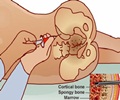
"Our findings, along with those from a Korean study, dispel the long-held doubts about the effectiveness of the new therapy", says Dr. Arne Jensen of the Campus Clinic Gynaecology. Together with his colleague Prof. Dr. Eckard Hamelmann of the Department of Paediatrics at the Catholic Hospital Bochum (University Clinic of the RUB), he reports in the journal "Case Reports in Transplantation".
At the end of November 2008, the child suffered from cardiac arrest with severe brain damage and was subsequently in a persistent vegetative state with his body paralysed. Up to now, there has been no treatment for the cause of what is known as infantile cerebral palsy. "In their desperate situation, the parents searched the literature for alternative therapies", Arne Jensen explains. "They contacted us and asked about the possibilities of using their son's cord blood, frozen at his birth."
Nine weeks after the brain damage, on 27 January 2009, the doctors administered the prepared blood intravenously. They studied the progress of recovery at 2, 5, 12, 24, 30, and 40 months after the insult. Usually, the chances of survival after such a severe brain damage and more than 25 minutes duration of resuscitation are six per cent. Months after the severe brain damage, the surviving children usually only exhibit minimal signs of consciousness. "The prognosis for the little patient was threatening if not hopeless", the Bochum medics say.
After the cord blood therapy, the patient, however, recovered relatively quickly. Within two months, the spasticity decreased significantly. He was able to see, sit, smile, and to speak simple words again. Forty months after treatment, the child was able to eat independently, walk with assistance, and form four-word sentences. "Of course, on the basis of these results, we cannot clearly say what the cause of the recovery is", Jensen says. "It is, however, very difficult to explain these remarkable effects by purely symptomatic treatment during active rehabilitation."
The study has been published in the journal "Case Reports in Transplantation".
Advertisement













